Project Management Assignment: Camden Concert Event Project Plan
VerifiedAdded on 2022/12/16
|12
|2297
|62
Project
AI Summary
This project management assignment focuses on the planning and execution of a musical concert event for the Camden Sickle Cell and Thalassaemia Service Group. The project plan encompasses several key areas, beginning with a project network diagram to visualize the sequence of activities and identify the critical path. A detailed stakeholder analysis is conducted to understand the interests and influence of various parties involved, both internal and external. The work breakdown structure (WBS) breaks down the project into manageable tasks, complemented by an organizational structure defining roles and responsibilities. A comprehensive risk analysis assesses potential challenges, including probability and impact, along with mitigation strategies. The assignment also addresses quality control measures to ensure project success and explores various project management methodologies, concluding that an agile approach is most suitable for the project's dynamic nature and potential for mid-term adjustments. The references section includes relevant books and journal articles supporting the analysis and methodologies used.

BM522 Project Management
Paraphrase This Document
Need a fresh take? Get an instant paraphrase of this document with our AI Paraphraser
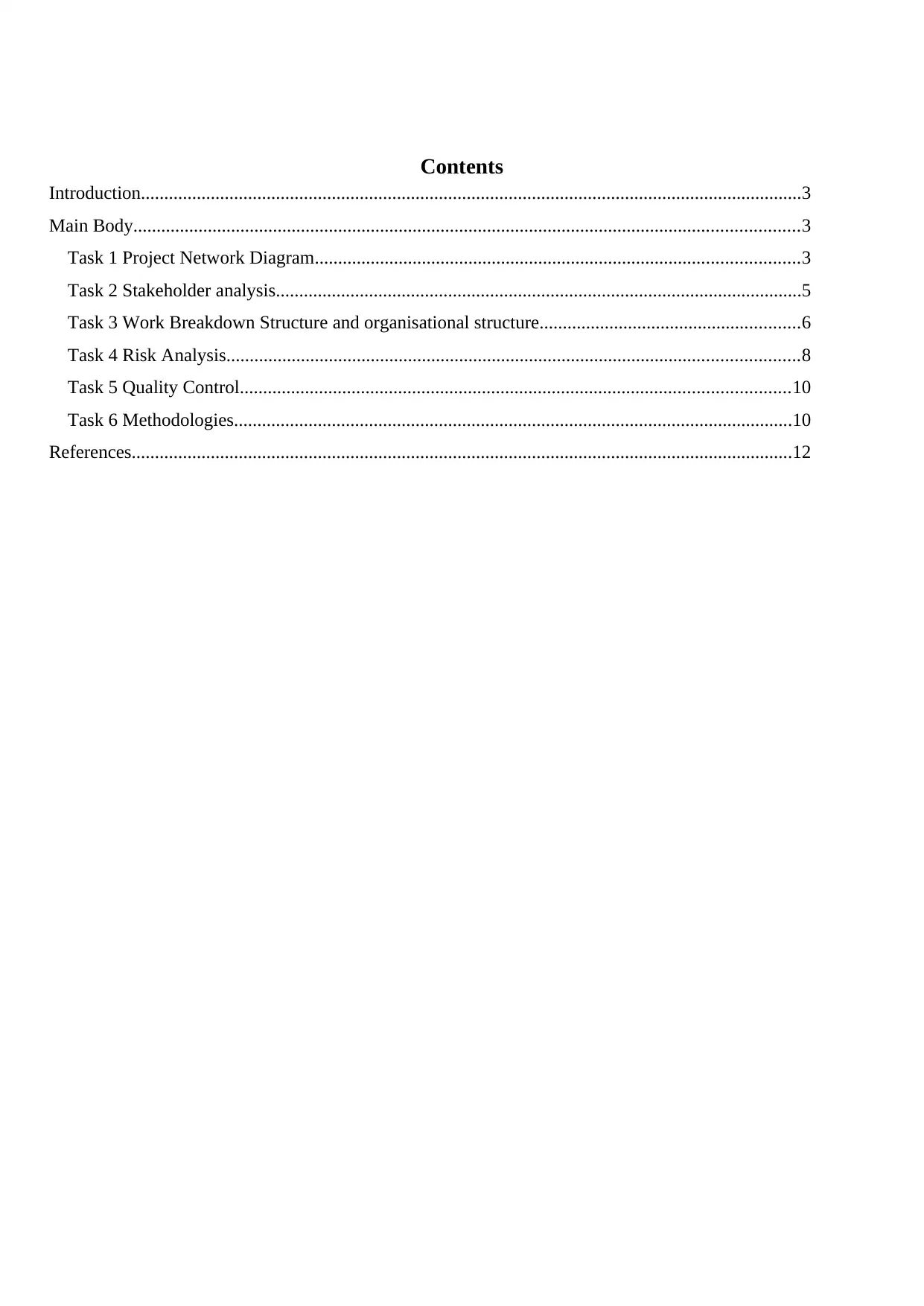
Contents
Introduction..............................................................................................................................................3
Main Body...............................................................................................................................................3
Task 1 Project Network Diagram........................................................................................................3
Task 2 Stakeholder analysis.................................................................................................................5
Task 3 Work Breakdown Structure and organisational structure........................................................6
Task 4 Risk Analysis...........................................................................................................................8
Task 5 Quality Control......................................................................................................................10
Task 6 Methodologies........................................................................................................................10
References..............................................................................................................................................12
Introduction..............................................................................................................................................3
Main Body...............................................................................................................................................3
Task 1 Project Network Diagram........................................................................................................3
Task 2 Stakeholder analysis.................................................................................................................5
Task 3 Work Breakdown Structure and organisational structure........................................................6
Task 4 Risk Analysis...........................................................................................................................8
Task 5 Quality Control......................................................................................................................10
Task 6 Methodologies........................................................................................................................10
References..............................................................................................................................................12
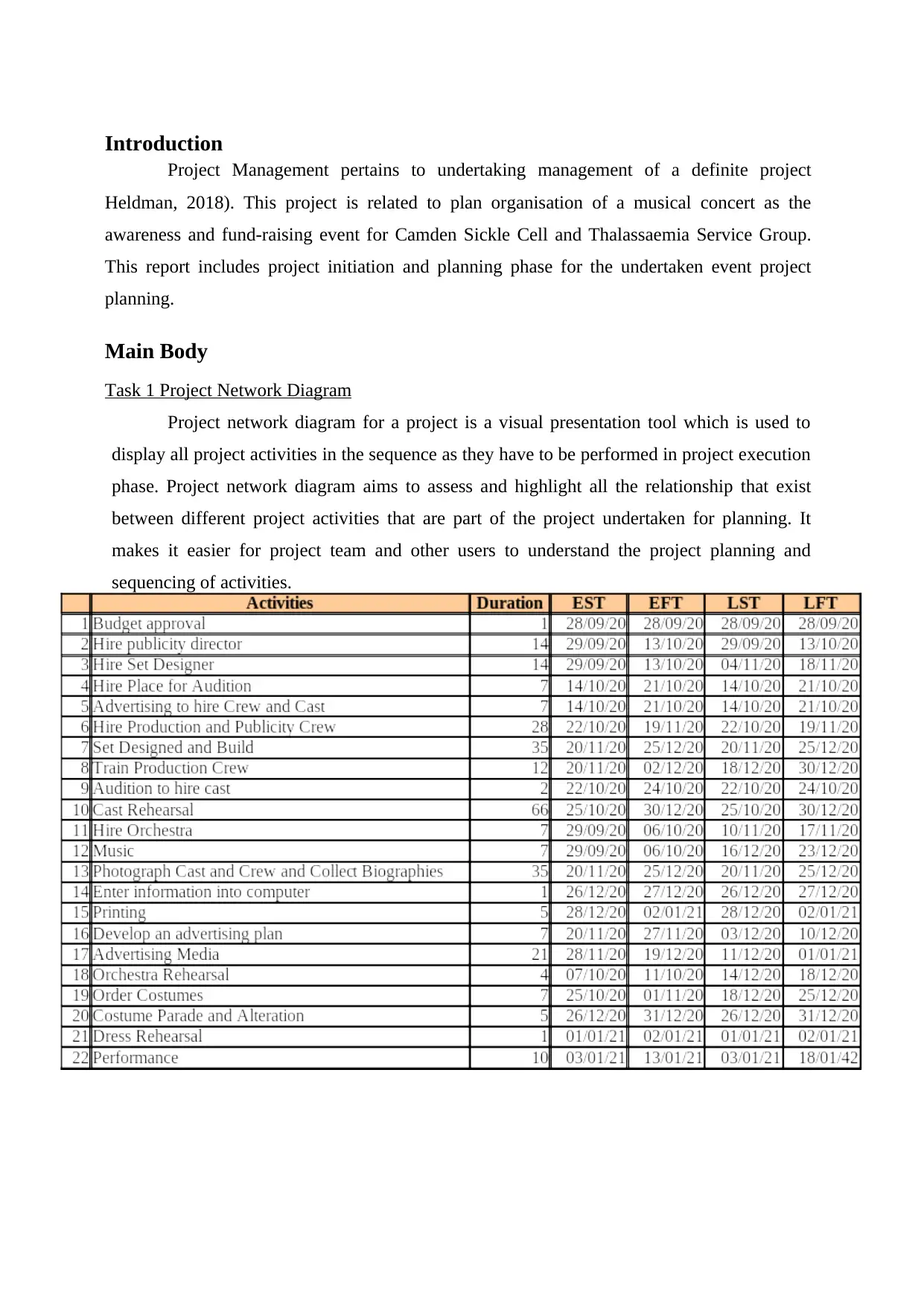
Introduction
Project Management pertains to undertaking management of a definite project
Heldman, 2018). This project is related to plan organisation of a musical concert as the
awareness and fund-raising event for Camden Sickle Cell and Thalassaemia Service Group.
This report includes project initiation and planning phase for the undertaken event project
planning.
Main Body
Task 1 Project Network Diagram
Project network diagram for a project is a visual presentation tool which is used to
display all project activities in the sequence as they have to be performed in project execution
phase. Project network diagram aims to assess and highlight all the relationship that exist
between different project activities that are part of the project undertaken for planning. It
makes it easier for project team and other users to understand the project planning and
sequencing of activities.
Project Management pertains to undertaking management of a definite project
Heldman, 2018). This project is related to plan organisation of a musical concert as the
awareness and fund-raising event for Camden Sickle Cell and Thalassaemia Service Group.
This report includes project initiation and planning phase for the undertaken event project
planning.
Main Body
Task 1 Project Network Diagram
Project network diagram for a project is a visual presentation tool which is used to
display all project activities in the sequence as they have to be performed in project execution
phase. Project network diagram aims to assess and highlight all the relationship that exist
between different project activities that are part of the project undertaken for planning. It
makes it easier for project team and other users to understand the project planning and
sequencing of activities.
⊘ This is a preview!⊘
Do you want full access?
Subscribe today to unlock all pages.

Trusted by 1+ million students worldwide
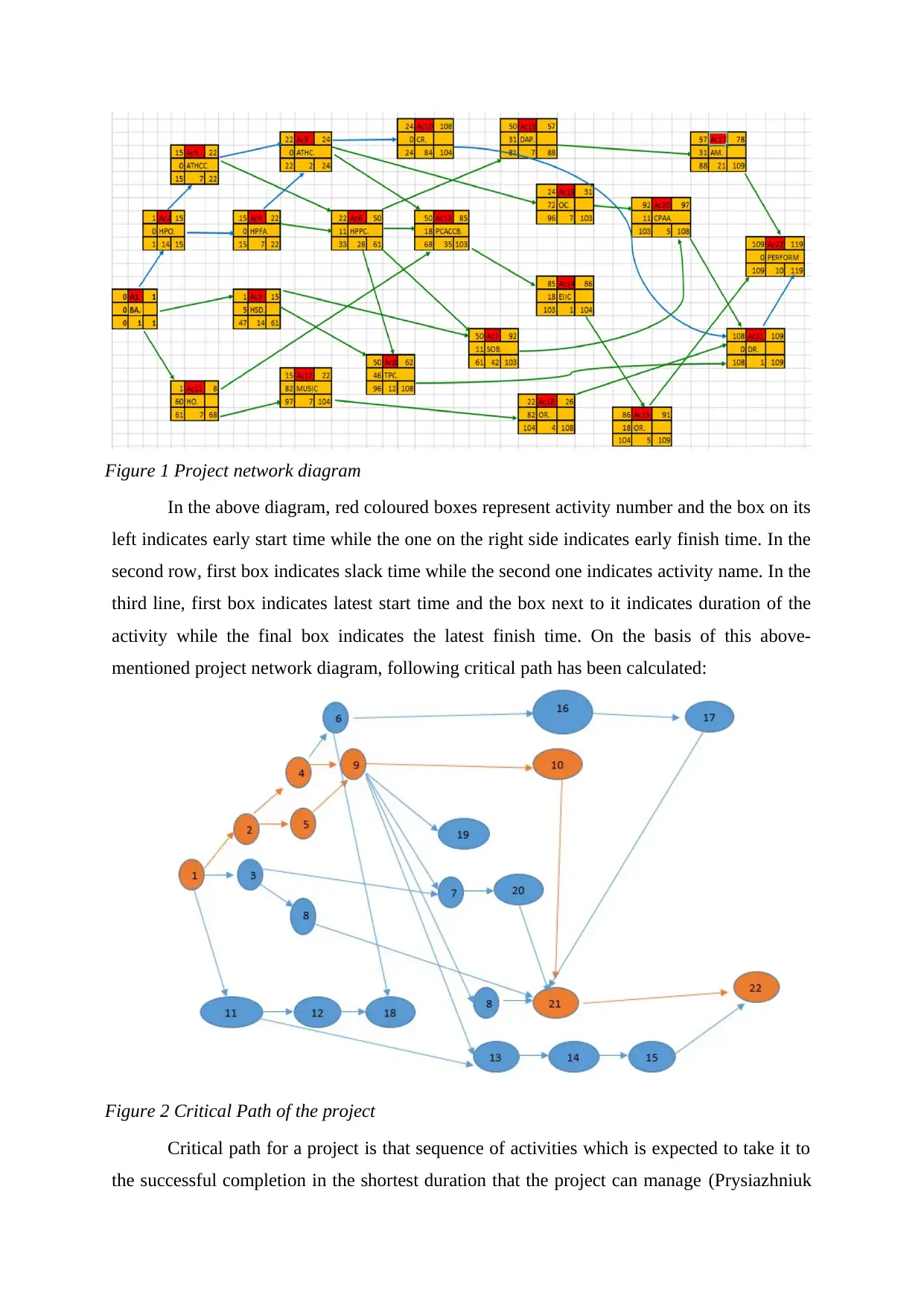
Figure 1 Project network diagram
In the above diagram, red coloured boxes represent activity number and the box on its
left indicates early start time while the one on the right side indicates early finish time. In the
second row, first box indicates slack time while the second one indicates activity name. In the
third line, first box indicates latest start time and the box next to it indicates duration of the
activity while the final box indicates the latest finish time. On the basis of this above-
mentioned project network diagram, following critical path has been calculated:
Figure 2 Critical Path of the project
Critical path for a project is that sequence of activities which is expected to take it to
the successful completion in the shortest duration that the project can manage (Prysiazhniuk
In the above diagram, red coloured boxes represent activity number and the box on its
left indicates early start time while the one on the right side indicates early finish time. In the
second row, first box indicates slack time while the second one indicates activity name. In the
third line, first box indicates latest start time and the box next to it indicates duration of the
activity while the final box indicates the latest finish time. On the basis of this above-
mentioned project network diagram, following critical path has been calculated:
Figure 2 Critical Path of the project
Critical path for a project is that sequence of activities which is expected to take it to
the successful completion in the shortest duration that the project can manage (Prysiazhniuk
Paraphrase This Document
Need a fresh take? Get an instant paraphrase of this document with our AI Paraphraser
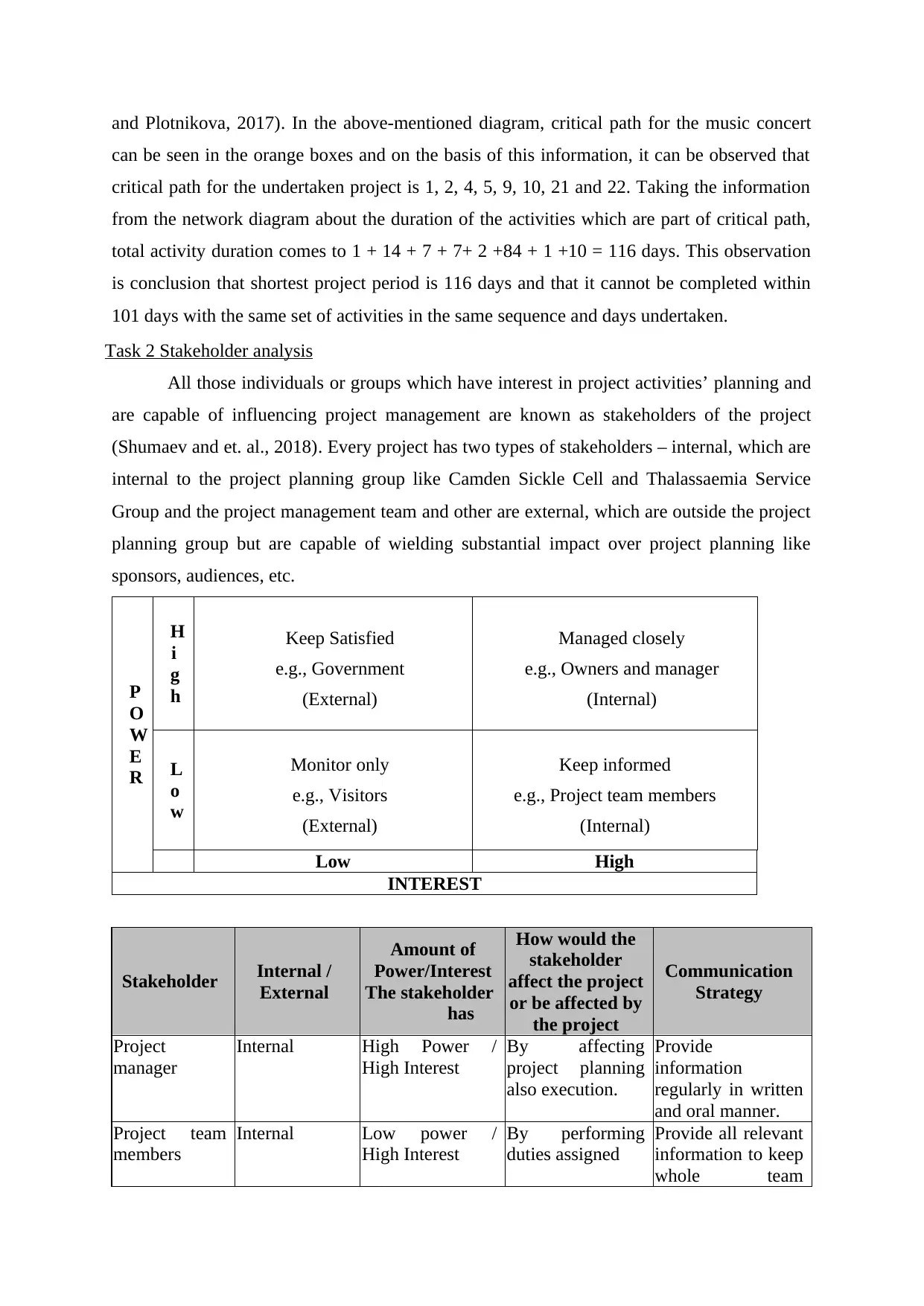
and Plotnikova, 2017). In the above-mentioned diagram, critical path for the music concert
can be seen in the orange boxes and on the basis of this information, it can be observed that
critical path for the undertaken project is 1, 2, 4, 5, 9, 10, 21 and 22. Taking the information
from the network diagram about the duration of the activities which are part of critical path,
total activity duration comes to 1 + 14 + 7 + 7+ 2 +84 + 1 +10 = 116 days. This observation
is conclusion that shortest project period is 116 days and that it cannot be completed within
101 days with the same set of activities in the same sequence and days undertaken.
Task 2 Stakeholder analysis
All those individuals or groups which have interest in project activities’ planning and
are capable of influencing project management are known as stakeholders of the project
(Shumaev and et. al., 2018). Every project has two types of stakeholders – internal, which are
internal to the project planning group like Camden Sickle Cell and Thalassaemia Service
Group and the project management team and other are external, which are outside the project
planning group but are capable of wielding substantial impact over project planning like
sponsors, audiences, etc.
P
O
W
E
R
H
i
g
h
Keep Satisfied
e.g., Government
(External)
Managed closely
e.g., Owners and manager
(Internal)
L
o
w
Monitor only
e.g., Visitors
(External)
Keep informed
e.g., Project team members
(Internal)
Low High
INTEREST
Stakeholder Internal /
External
Amount of
Power/Interest
The stakeholder
has
How would the
stakeholder
affect the project
or be affected by
the project
Communication
Strategy
Project
manager
Internal High Power /
High Interest
By affecting
project planning
also execution.
Provide
information
regularly in written
and oral manner.
Project team
members
Internal Low power /
High Interest
By performing
duties assigned
Provide all relevant
information to keep
whole team
can be seen in the orange boxes and on the basis of this information, it can be observed that
critical path for the undertaken project is 1, 2, 4, 5, 9, 10, 21 and 22. Taking the information
from the network diagram about the duration of the activities which are part of critical path,
total activity duration comes to 1 + 14 + 7 + 7+ 2 +84 + 1 +10 = 116 days. This observation
is conclusion that shortest project period is 116 days and that it cannot be completed within
101 days with the same set of activities in the same sequence and days undertaken.
Task 2 Stakeholder analysis
All those individuals or groups which have interest in project activities’ planning and
are capable of influencing project management are known as stakeholders of the project
(Shumaev and et. al., 2018). Every project has two types of stakeholders – internal, which are
internal to the project planning group like Camden Sickle Cell and Thalassaemia Service
Group and the project management team and other are external, which are outside the project
planning group but are capable of wielding substantial impact over project planning like
sponsors, audiences, etc.
P
O
W
E
R
H
i
g
h
Keep Satisfied
e.g., Government
(External)
Managed closely
e.g., Owners and manager
(Internal)
L
o
w
Monitor only
e.g., Visitors
(External)
Keep informed
e.g., Project team members
(Internal)
Low High
INTEREST
Stakeholder Internal /
External
Amount of
Power/Interest
The stakeholder
has
How would the
stakeholder
affect the project
or be affected by
the project
Communication
Strategy
Project
manager
Internal High Power /
High Interest
By affecting
project planning
also execution.
Provide
information
regularly in written
and oral manner.
Project team
members
Internal Low power /
High Interest
By performing
duties assigned
Provide all relevant
information to keep
whole team
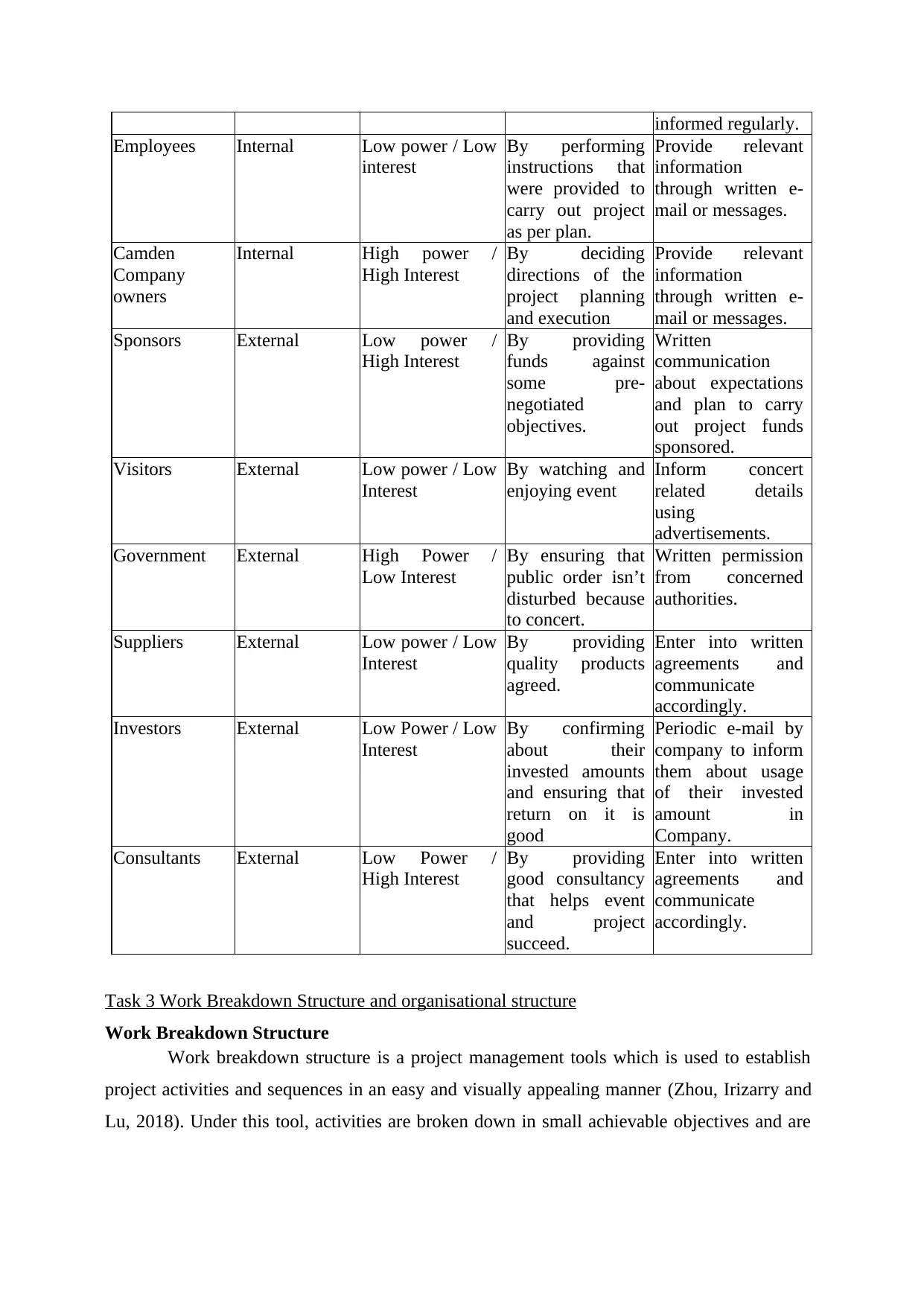
informed regularly.
Employees Internal Low power / Low
interest
By performing
instructions that
were provided to
carry out project
as per plan.
Provide relevant
information
through written e-
mail or messages.
Camden
Company
owners
Internal High power /
High Interest
By deciding
directions of the
project planning
and execution
Provide relevant
information
through written e-
mail or messages.
Sponsors External Low power /
High Interest
By providing
funds against
some pre-
negotiated
objectives.
Written
communication
about expectations
and plan to carry
out project funds
sponsored.
Visitors External Low power / Low
Interest
By watching and
enjoying event
Inform concert
related details
using
advertisements.
Government External High Power /
Low Interest
By ensuring that
public order isn’t
disturbed because
to concert.
Written permission
from concerned
authorities.
Suppliers External Low power / Low
Interest
By providing
quality products
agreed.
Enter into written
agreements and
communicate
accordingly.
Investors External Low Power / Low
Interest
By confirming
about their
invested amounts
and ensuring that
return on it is
good
Periodic e-mail by
company to inform
them about usage
of their invested
amount in
Company.
Consultants External Low Power /
High Interest
By providing
good consultancy
that helps event
and project
succeed.
Enter into written
agreements and
communicate
accordingly.
Task 3 Work Breakdown Structure and organisational structure
Work Breakdown Structure
Work breakdown structure is a project management tools which is used to establish
project activities and sequences in an easy and visually appealing manner (Zhou, Irizarry and
Lu, 2018). Under this tool, activities are broken down in small achievable objectives and are
Employees Internal Low power / Low
interest
By performing
instructions that
were provided to
carry out project
as per plan.
Provide relevant
information
through written e-
mail or messages.
Camden
Company
owners
Internal High power /
High Interest
By deciding
directions of the
project planning
and execution
Provide relevant
information
through written e-
mail or messages.
Sponsors External Low power /
High Interest
By providing
funds against
some pre-
negotiated
objectives.
Written
communication
about expectations
and plan to carry
out project funds
sponsored.
Visitors External Low power / Low
Interest
By watching and
enjoying event
Inform concert
related details
using
advertisements.
Government External High Power /
Low Interest
By ensuring that
public order isn’t
disturbed because
to concert.
Written permission
from concerned
authorities.
Suppliers External Low power / Low
Interest
By providing
quality products
agreed.
Enter into written
agreements and
communicate
accordingly.
Investors External Low Power / Low
Interest
By confirming
about their
invested amounts
and ensuring that
return on it is
good
Periodic e-mail by
company to inform
them about usage
of their invested
amount in
Company.
Consultants External Low Power /
High Interest
By providing
good consultancy
that helps event
and project
succeed.
Enter into written
agreements and
communicate
accordingly.
Task 3 Work Breakdown Structure and organisational structure
Work Breakdown Structure
Work breakdown structure is a project management tools which is used to establish
project activities and sequences in an easy and visually appealing manner (Zhou, Irizarry and
Lu, 2018). Under this tool, activities are broken down in small achievable objectives and are
⊘ This is a preview!⊘
Do you want full access?
Subscribe today to unlock all pages.

Trusted by 1+ million students worldwide
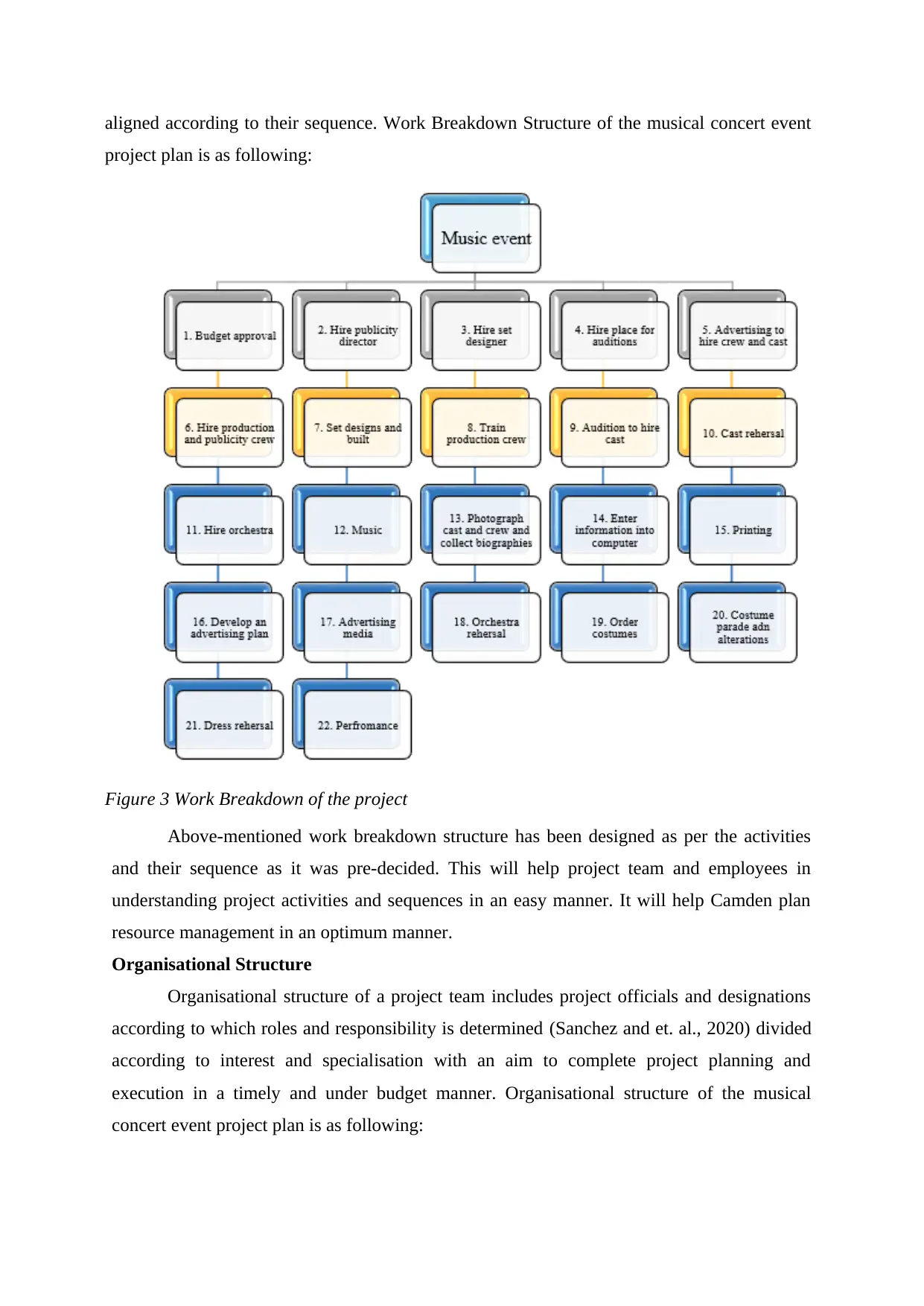
aligned according to their sequence. Work Breakdown Structure of the musical concert event
project plan is as following:
Figure 3 Work Breakdown of the project
Above-mentioned work breakdown structure has been designed as per the activities
and their sequence as it was pre-decided. This will help project team and employees in
understanding project activities and sequences in an easy manner. It will help Camden plan
resource management in an optimum manner.
Organisational Structure
Organisational structure of a project team includes project officials and designations
according to which roles and responsibility is determined (Sanchez and et. al., 2020) divided
according to interest and specialisation with an aim to complete project planning and
execution in a timely and under budget manner. Organisational structure of the musical
concert event project plan is as following:
project plan is as following:
Figure 3 Work Breakdown of the project
Above-mentioned work breakdown structure has been designed as per the activities
and their sequence as it was pre-decided. This will help project team and employees in
understanding project activities and sequences in an easy manner. It will help Camden plan
resource management in an optimum manner.
Organisational Structure
Organisational structure of a project team includes project officials and designations
according to which roles and responsibility is determined (Sanchez and et. al., 2020) divided
according to interest and specialisation with an aim to complete project planning and
execution in a timely and under budget manner. Organisational structure of the musical
concert event project plan is as following:
Paraphrase This Document
Need a fresh take? Get an instant paraphrase of this document with our AI Paraphraser
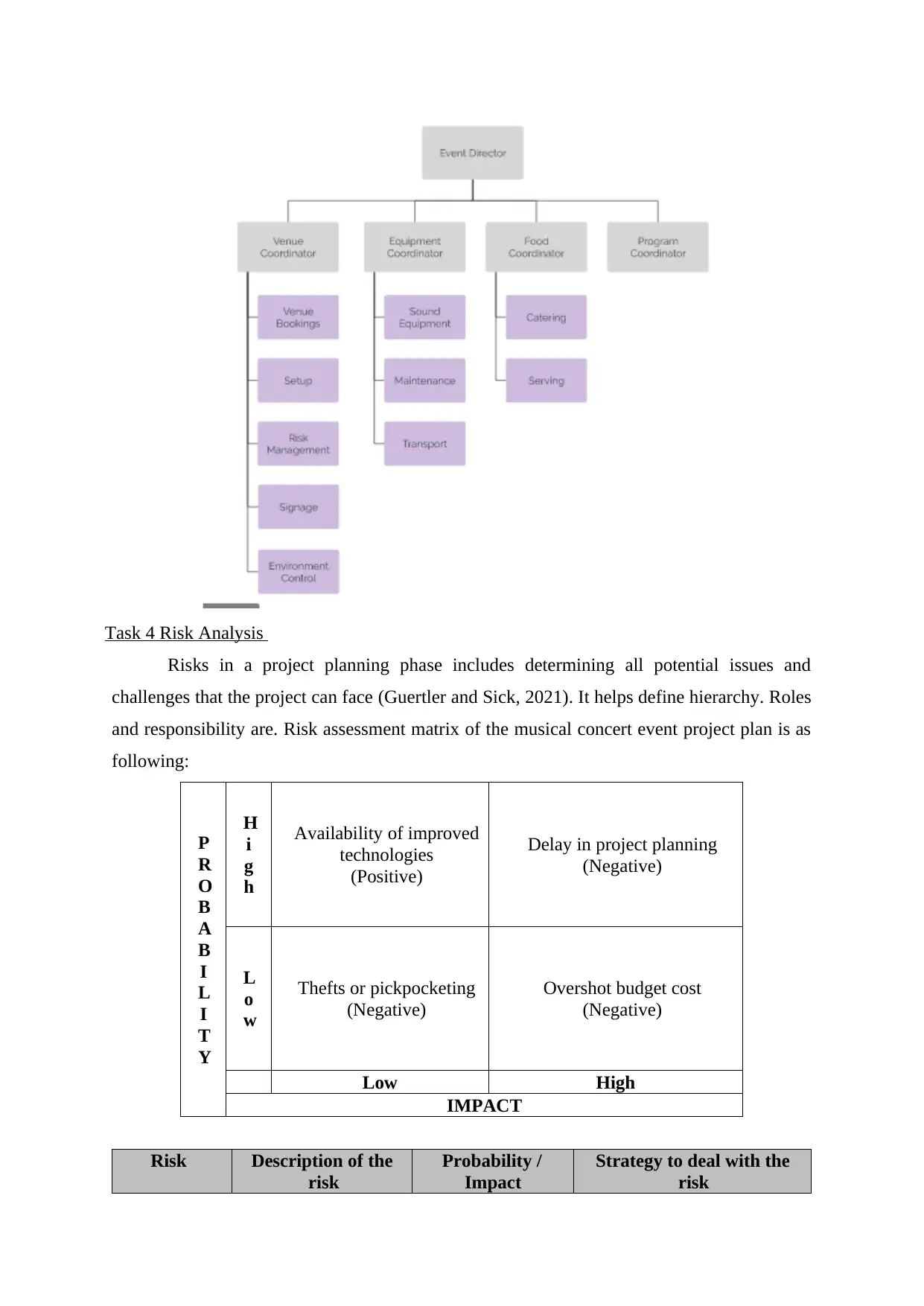
Task 4 Risk Analysis
Risks in a project planning phase includes determining all potential issues and
challenges that the project can face (Guertler and Sick, 2021). It helps define hierarchy. Roles
and responsibility are. Risk assessment matrix of the musical concert event project plan is as
following:
P
R
O
B
A
B
I
L
I
T
Y
H
i
g
h
Availability of improved
technologies
(Positive)
Delay in project planning
(Negative)
L
o
w
Thefts or pickpocketing
(Negative)
Overshot budget cost
(Negative)
Low High
IMPACT
Risk Description of the
risk
Probability /
Impact
Strategy to deal with the
risk
Risks in a project planning phase includes determining all potential issues and
challenges that the project can face (Guertler and Sick, 2021). It helps define hierarchy. Roles
and responsibility are. Risk assessment matrix of the musical concert event project plan is as
following:
P
R
O
B
A
B
I
L
I
T
Y
H
i
g
h
Availability of improved
technologies
(Positive)
Delay in project planning
(Negative)
L
o
w
Thefts or pickpocketing
(Negative)
Overshot budget cost
(Negative)
Low High
IMPACT
Risk Description of the
risk
Probability /
Impact
Strategy to deal with the
risk
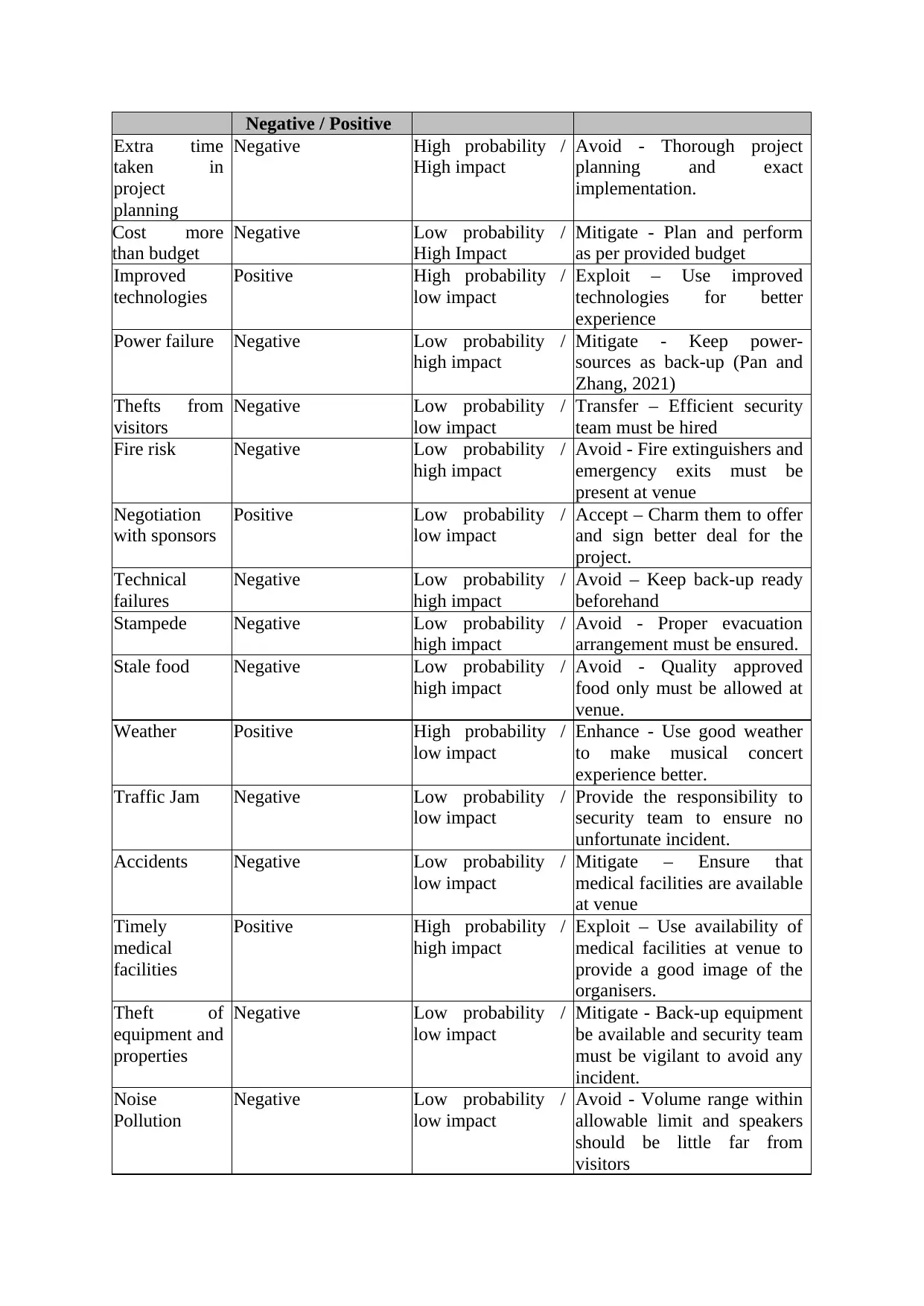
Negative / Positive
Extra time
taken in
project
planning
Negative High probability /
High impact
Avoid - Thorough project
planning and exact
implementation.
Cost more
than budget
Negative Low probability /
High Impact
Mitigate - Plan and perform
as per provided budget
Improved
technologies
Positive High probability /
low impact
Exploit – Use improved
technologies for better
experience
Power failure Negative Low probability /
high impact
Mitigate - Keep power-
sources as back-up (Pan and
Zhang, 2021)
Thefts from
visitors
Negative Low probability /
low impact
Transfer – Efficient security
team must be hired
Fire risk Negative Low probability /
high impact
Avoid - Fire extinguishers and
emergency exits must be
present at venue
Negotiation
with sponsors
Positive Low probability /
low impact
Accept – Charm them to offer
and sign better deal for the
project.
Technical
failures
Negative Low probability /
high impact
Avoid – Keep back-up ready
beforehand
Stampede Negative Low probability /
high impact
Avoid - Proper evacuation
arrangement must be ensured.
Stale food Negative Low probability /
high impact
Avoid - Quality approved
food only must be allowed at
venue.
Weather Positive High probability /
low impact
Enhance - Use good weather
to make musical concert
experience better.
Traffic Jam Negative Low probability /
low impact
Provide the responsibility to
security team to ensure no
unfortunate incident.
Accidents Negative Low probability /
low impact
Mitigate – Ensure that
medical facilities are available
at venue
Timely
medical
facilities
Positive High probability /
high impact
Exploit – Use availability of
medical facilities at venue to
provide a good image of the
organisers.
Theft of
equipment and
properties
Negative Low probability /
low impact
Mitigate - Back-up equipment
be available and security team
must be vigilant to avoid any
incident.
Noise
Pollution
Negative Low probability /
low impact
Avoid - Volume range within
allowable limit and speakers
should be little far from
visitors
Extra time
taken in
project
planning
Negative High probability /
High impact
Avoid - Thorough project
planning and exact
implementation.
Cost more
than budget
Negative Low probability /
High Impact
Mitigate - Plan and perform
as per provided budget
Improved
technologies
Positive High probability /
low impact
Exploit – Use improved
technologies for better
experience
Power failure Negative Low probability /
high impact
Mitigate - Keep power-
sources as back-up (Pan and
Zhang, 2021)
Thefts from
visitors
Negative Low probability /
low impact
Transfer – Efficient security
team must be hired
Fire risk Negative Low probability /
high impact
Avoid - Fire extinguishers and
emergency exits must be
present at venue
Negotiation
with sponsors
Positive Low probability /
low impact
Accept – Charm them to offer
and sign better deal for the
project.
Technical
failures
Negative Low probability /
high impact
Avoid – Keep back-up ready
beforehand
Stampede Negative Low probability /
high impact
Avoid - Proper evacuation
arrangement must be ensured.
Stale food Negative Low probability /
high impact
Avoid - Quality approved
food only must be allowed at
venue.
Weather Positive High probability /
low impact
Enhance - Use good weather
to make musical concert
experience better.
Traffic Jam Negative Low probability /
low impact
Provide the responsibility to
security team to ensure no
unfortunate incident.
Accidents Negative Low probability /
low impact
Mitigate – Ensure that
medical facilities are available
at venue
Timely
medical
facilities
Positive High probability /
high impact
Exploit – Use availability of
medical facilities at venue to
provide a good image of the
organisers.
Theft of
equipment and
properties
Negative Low probability /
low impact
Mitigate - Back-up equipment
be available and security team
must be vigilant to avoid any
incident.
Noise
Pollution
Negative Low probability /
low impact
Avoid - Volume range within
allowable limit and speakers
should be little far from
visitors
⊘ This is a preview!⊘
Do you want full access?
Subscribe today to unlock all pages.

Trusted by 1+ million students worldwide
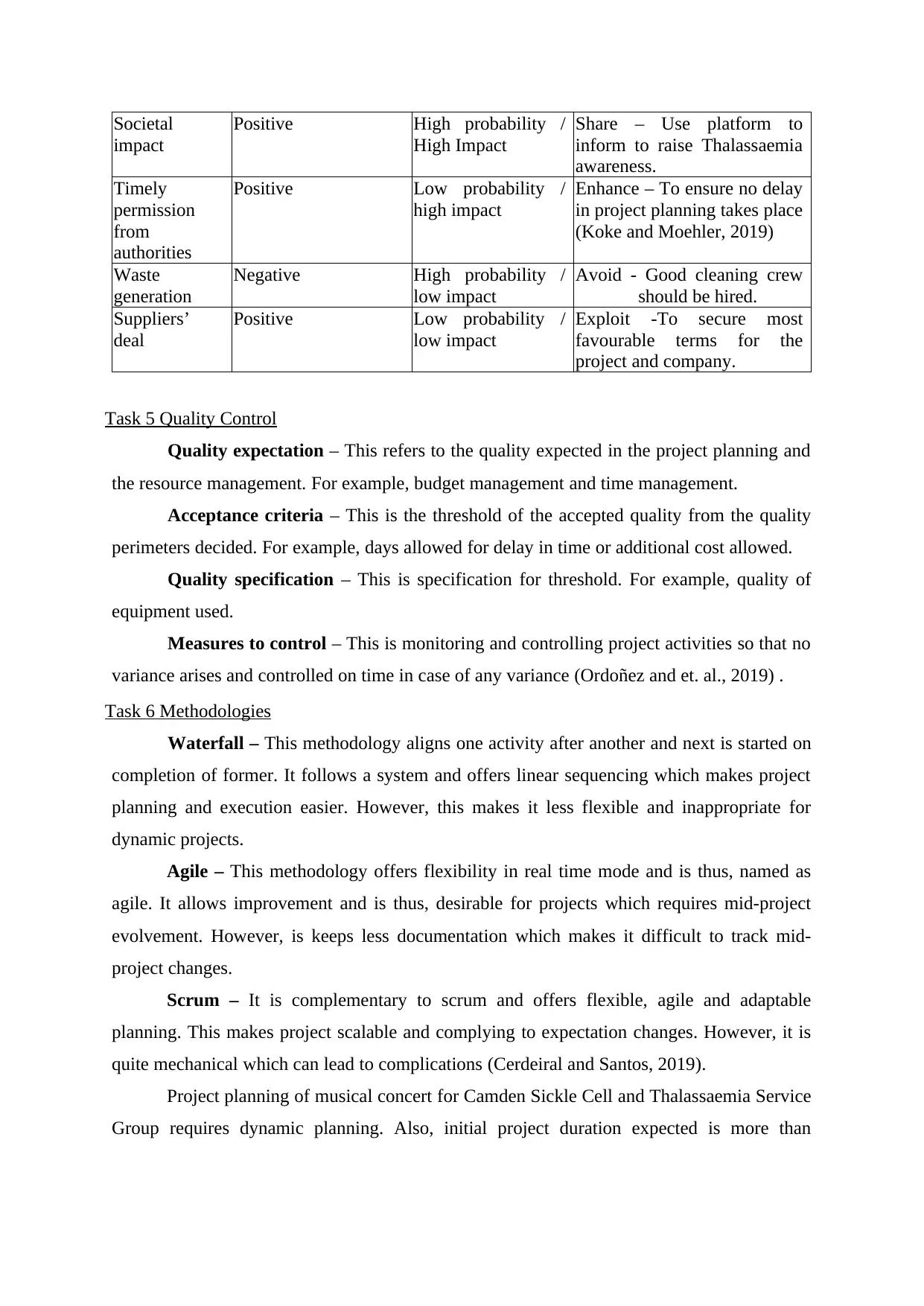
Societal
impact
Positive High probability /
High Impact
Share – Use platform to
inform to raise Thalassaemia
awareness.
Timely
permission
from
authorities
Positive Low probability /
high impact
Enhance – To ensure no delay
in project planning takes place
(Koke and Moehler, 2019)
Waste
generation
Negative High probability /
low impact
Avoid - Good cleaning crew
should be hired.
Suppliers’
deal
Positive Low probability /
low impact
Exploit -To secure most
favourable terms for the
project and company.
Task 5 Quality Control
Quality expectation – This refers to the quality expected in the project planning and
the resource management. For example, budget management and time management.
Acceptance criteria – This is the threshold of the accepted quality from the quality
perimeters decided. For example, days allowed for delay in time or additional cost allowed.
Quality specification – This is specification for threshold. For example, quality of
equipment used.
Measures to control – This is monitoring and controlling project activities so that no
variance arises and controlled on time in case of any variance (Ordoñez and et. al., 2019) .
Task 6 Methodologies
Waterfall – This methodology aligns one activity after another and next is started on
completion of former. It follows a system and offers linear sequencing which makes project
planning and execution easier. However, this makes it less flexible and inappropriate for
dynamic projects.
Agile – This methodology offers flexibility in real time mode and is thus, named as
agile. It allows improvement and is thus, desirable for projects which requires mid-project
evolvement. However, is keeps less documentation which makes it difficult to track mid-
project changes.
Scrum – It is complementary to scrum and offers flexible, agile and adaptable
planning. This makes project scalable and complying to expectation changes. However, it is
quite mechanical which can lead to complications (Cerdeiral and Santos, 2019).
Project planning of musical concert for Camden Sickle Cell and Thalassaemia Service
Group requires dynamic planning. Also, initial project duration expected is more than
impact
Positive High probability /
High Impact
Share – Use platform to
inform to raise Thalassaemia
awareness.
Timely
permission
from
authorities
Positive Low probability /
high impact
Enhance – To ensure no delay
in project planning takes place
(Koke and Moehler, 2019)
Waste
generation
Negative High probability /
low impact
Avoid - Good cleaning crew
should be hired.
Suppliers’
deal
Positive Low probability /
low impact
Exploit -To secure most
favourable terms for the
project and company.
Task 5 Quality Control
Quality expectation – This refers to the quality expected in the project planning and
the resource management. For example, budget management and time management.
Acceptance criteria – This is the threshold of the accepted quality from the quality
perimeters decided. For example, days allowed for delay in time or additional cost allowed.
Quality specification – This is specification for threshold. For example, quality of
equipment used.
Measures to control – This is monitoring and controlling project activities so that no
variance arises and controlled on time in case of any variance (Ordoñez and et. al., 2019) .
Task 6 Methodologies
Waterfall – This methodology aligns one activity after another and next is started on
completion of former. It follows a system and offers linear sequencing which makes project
planning and execution easier. However, this makes it less flexible and inappropriate for
dynamic projects.
Agile – This methodology offers flexibility in real time mode and is thus, named as
agile. It allows improvement and is thus, desirable for projects which requires mid-project
evolvement. However, is keeps less documentation which makes it difficult to track mid-
project changes.
Scrum – It is complementary to scrum and offers flexible, agile and adaptable
planning. This makes project scalable and complying to expectation changes. However, it is
quite mechanical which can lead to complications (Cerdeiral and Santos, 2019).
Project planning of musical concert for Camden Sickle Cell and Thalassaemia Service
Group requires dynamic planning. Also, initial project duration expected is more than
Paraphrase This Document
Need a fresh take? Get an instant paraphrase of this document with our AI Paraphraser

allowed which means that project would require mid-term changes. All this make agile
methodology suitable with required evolvements incorporated and accommodated.
methodology suitable with required evolvements incorporated and accommodated.
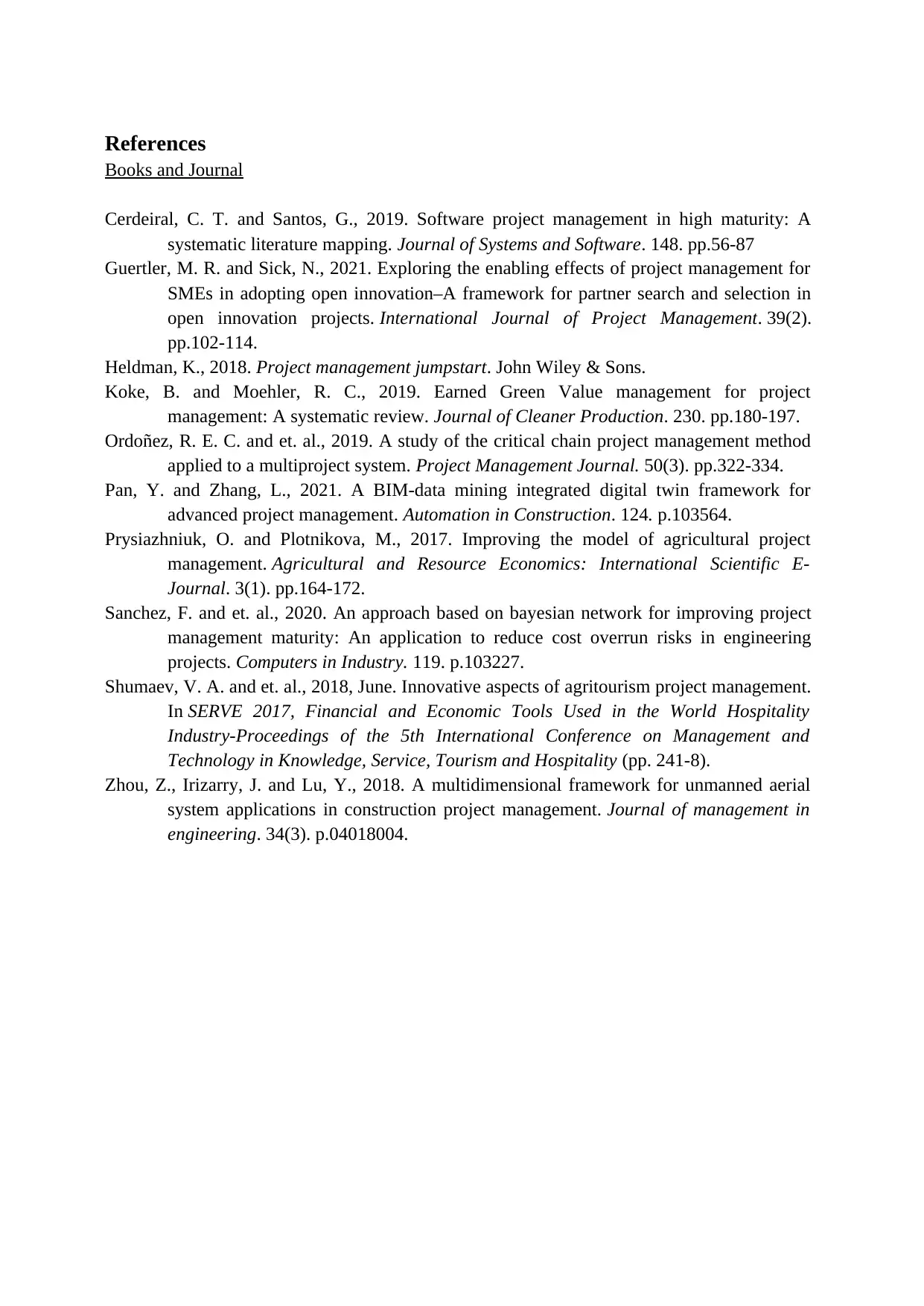
References
Books and Journal
Cerdeiral, C. T. and Santos, G., 2019. Software project management in high maturity: A
systematic literature mapping. Journal of Systems and Software. 148. pp.56-87
Guertler, M. R. and Sick, N., 2021. Exploring the enabling effects of project management for
SMEs in adopting open innovation–A framework for partner search and selection in
open innovation projects. International Journal of Project Management. 39(2).
pp.102-114.
Heldman, K., 2018. Project management jumpstart. John Wiley & Sons.
Koke, B. and Moehler, R. C., 2019. Earned Green Value management for project
management: A systematic review. Journal of Cleaner Production. 230. pp.180-197.
Ordoñez, R. E. C. and et. al., 2019. A study of the critical chain project management method
applied to a multiproject system. Project Management Journal. 50(3). pp.322-334.
Pan, Y. and Zhang, L., 2021. A BIM-data mining integrated digital twin framework for
advanced project management. Automation in Construction. 124. p.103564.
Prysiazhniuk, O. and Plotnikova, M., 2017. Improving the model of agricultural project
management. Agricultural and Resource Economics: International Scientific E-
Journal. 3(1). pp.164-172.
Sanchez, F. and et. al., 2020. An approach based on bayesian network for improving project
management maturity: An application to reduce cost overrun risks in engineering
projects. Computers in Industry. 119. p.103227.
Shumaev, V. A. and et. al., 2018, June. Innovative aspects of agritourism project management.
In SERVE 2017, Financial and Economic Tools Used in the World Hospitality
Industry-Proceedings of the 5th International Conference on Management and
Technology in Knowledge, Service, Tourism and Hospitality (pp. 241-8).
Zhou, Z., Irizarry, J. and Lu, Y., 2018. A multidimensional framework for unmanned aerial
system applications in construction project management. Journal of management in
engineering. 34(3). p.04018004.
Books and Journal
Cerdeiral, C. T. and Santos, G., 2019. Software project management in high maturity: A
systematic literature mapping. Journal of Systems and Software. 148. pp.56-87
Guertler, M. R. and Sick, N., 2021. Exploring the enabling effects of project management for
SMEs in adopting open innovation–A framework for partner search and selection in
open innovation projects. International Journal of Project Management. 39(2).
pp.102-114.
Heldman, K., 2018. Project management jumpstart. John Wiley & Sons.
Koke, B. and Moehler, R. C., 2019. Earned Green Value management for project
management: A systematic review. Journal of Cleaner Production. 230. pp.180-197.
Ordoñez, R. E. C. and et. al., 2019. A study of the critical chain project management method
applied to a multiproject system. Project Management Journal. 50(3). pp.322-334.
Pan, Y. and Zhang, L., 2021. A BIM-data mining integrated digital twin framework for
advanced project management. Automation in Construction. 124. p.103564.
Prysiazhniuk, O. and Plotnikova, M., 2017. Improving the model of agricultural project
management. Agricultural and Resource Economics: International Scientific E-
Journal. 3(1). pp.164-172.
Sanchez, F. and et. al., 2020. An approach based on bayesian network for improving project
management maturity: An application to reduce cost overrun risks in engineering
projects. Computers in Industry. 119. p.103227.
Shumaev, V. A. and et. al., 2018, June. Innovative aspects of agritourism project management.
In SERVE 2017, Financial and Economic Tools Used in the World Hospitality
Industry-Proceedings of the 5th International Conference on Management and
Technology in Knowledge, Service, Tourism and Hospitality (pp. 241-8).
Zhou, Z., Irizarry, J. and Lu, Y., 2018. A multidimensional framework for unmanned aerial
system applications in construction project management. Journal of management in
engineering. 34(3). p.04018004.
⊘ This is a preview!⊘
Do you want full access?
Subscribe today to unlock all pages.

Trusted by 1+ million students worldwide
1 out of 12
Related Documents
Your All-in-One AI-Powered Toolkit for Academic Success.
+13062052269
info@desklib.com
Available 24*7 on WhatsApp / Email
![[object Object]](/_next/static/media/star-bottom.7253800d.svg)
Unlock your academic potential
Copyright © 2020–2025 A2Z Services. All Rights Reserved. Developed and managed by ZUCOL.





